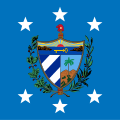Carlos Hevia
| Carlos Hevia | |
|---|---|
 | |
| President of Cuba | |
|
In office 15 January 1934 – 18 January 1934 | |
| Vice President | None |
| Preceded by | Ramón Grau |
| Succeeded by | Manuel Márquez Sterling |
| Personal details | |
| Born |
Carlos Hevia y de los Reyes-Gavilan March 21, 1900 Havana, Cuba |
| Died |
April 2, 1964 (aged 64) Lantana, Florida, United States |
| Nationality |
|
| Political party | Cuban Revolutionary Party |
| Spouse(s) | Elisa Edelmann |
| Children | Aurelio Carlos and Margarita Hevia-Edelmann |
| Occupation | Medical Doctor |
Carlos Hevia y de los Reyes-Gavilan (March 21, 1900 – April 2, 1964) was the President of Cuba, serving for less than three days. During the third week of 1934, Hevia was President from 5:00 p.m. on Monday, January 15, until 1:20 a.m. on Thursday, January 18.[1] Cuban junta leader Fulgencio Batista had obtained the resignation of Hevia's predecessor, Ramón Grau. The choice of Hevia was unpopular with the military, and by Wednesday, the new President was asked to resign. He was replaced by Manuel Márquez Sterling.
Presidency of Cuba
Hevia was the Agricultural Minister when rioting broke out in Havana protest against the President Grau. The junta requested Grau's resignation and named Hevia as the new president. Hevia initially declined, after hearing the reaction of the mob. After 100 troops arrived from Camp Columbia to guard the presidential palace, Hevia accepted the post at 5:00 Monday afternoon.[2] Hevia met with Batista's rival, union leader Carlos Mendieta, in the early hours of Tuesday morning. Hoping to receive Menideta's endorsement, Hevia came away instead with little more than Mendieta's pledge of neutrality. Hevia was administered the oath of office on Tuesday by his father-in-law, Dr. Juan Federico Edelmann, who was also the president (chief justice) of the Cuban Supreme Court [3] and a 21 gun salute was given from the cannons of the Cabanas Fortress following the inauguration. Meanwhile, labor organizations made plans for a nationwide strike.[4] Wednesday, Hevia was unable to forestall the Nationalist Union's plans for a walkout, and decided that evening to resign. About 40 hours after he had been formally inaugurated, Hevia resigned early Thursday morning in favor of Mendieta. He left the presidential palace at 2:15 a.m., saying "I am going back to my cane fields to cut cane," [5]
Hevia, who was also a surgeon, had been the first Cuban national to graduate from the United States Naval Academy at Annapolis, as a member of the Class of 1920. [6]
Hevia later broke with Batista and became an important politician in the Autentico party. He served as foreign minister of Cuba from 1948 to 1950, in the administration of Carlos Prio. Hevia was chosen to be the Autentico presidential candidate for the 1952 elections. However, the elections, in which Hevia's main opponents were Roberto Agramonte and Fulgencio Batista, were canceled when Batista took power in a military coup.
Hevia went into exile in the United States and during the early 1960s was part of groups opposed to Fidel Castro who overthrew Batista in 1959.
Family
He was the oldest of six children born to Aurelio Hevia y Alcalde, an attorney, and Sara de los Reyes-Gavilán y de la Guardia. He was married to Elisa Edelmann y Ponce and they had two children, Aurelio Carlos and Margarita Hevia-Edelmann. Hevia, who operated a "private naval academy" in Miami, died of a heart attack on April 2, 1964 [7]
Notes
- ↑ "Ramon Grau San Martin", Current Biography 1944 (H.W. Wilson Co., 1944), p254
- ↑ "Shooting Greets New President In Strife-Torn Cuba," The Fresno Bee, January 15, 1934, p1
- ↑ "Civil War in Cuba Perils Hevia Reign," Oakland Tribune, Jan. 16, 1934, p3
- ↑ "Cuban Strike is Scheduled For To-Day By Labor Group," Modesto Bee, Jan. 17, 1934, p3
- ↑ "Havana is Tied Up By Big Strike," Oakland Tribune, January 18, 1934, p1
- ↑ "The 1920 Lucky Bag, the Annual of the United States Naval Academy"
- ↑ "Cuban Exchief Dies," Modesto (Cal.) Bee, April 3, 1964, p18
References
- Fulgencio Batista, From Revolutionary to Strongman (Rutgers University Press, 2006, ISBN 978-0-8135-3701-6)
- Otero, Juan Joaquin (1954). Libro De Cuba, Una Enciclopedia Ilustrada Que Abarca Las Artes, Las Letras, Las Ciencias, La Economia, La Politica, La Historia, La Docencia, Y ElProgreso General De La Nacion Cubana - Edicion Conmemorative del Cincuentenario de la Republica de Cuba, 1902–1952. (Spanish)
External links
- A film clip "Longines Chronoscope with Carlos Hevia" is available at the Internet Archive
| Political offices | ||
|---|---|---|
| Preceded by Ramón Grau |
President of Cuba 15–18 January 1934 |
Succeeded by Manuel Márquez Sterling |
| Preceded by Alberto Inocente Álvarez |
Foreign Minister of Cuba 1948–1950 |
Succeeded by Ernesto Dihigo y Lopez Trigo |
